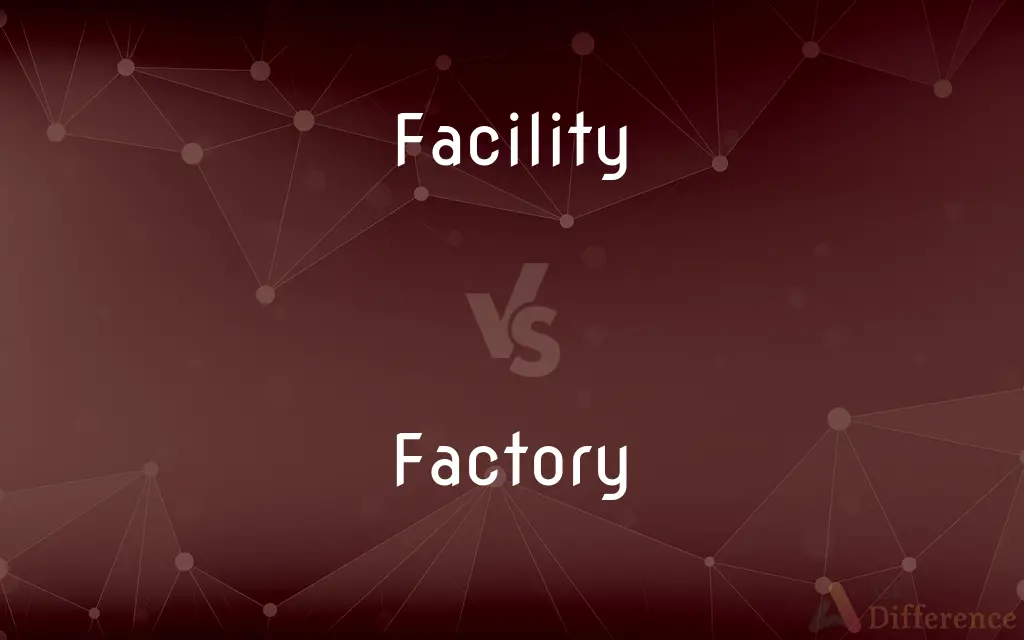Facility vs. Factory — What's the Difference?
By Urooj Arif & Fiza Rafique — Updated on February 28, 2024
A facility is a broad term for any space designed for a specific purpose, like hospitals or schools, while a factory is a type of facility specifically designed for manufacturing goods.

Difference Between Facility and Factory
Table of Contents
ADVERTISEMENT
Key Differences
A facility encompasses various types of buildings or spaces designed for specific functions or services, including but not limited to hospitals, schools, warehouses, and recreational centers. It is a general term that can refer to any place that facilitates a particular activity or service. In contrast, a factory is a specialized type of facility dedicated exclusively to manufacturing goods and products. Factories are designed to house machinery, equipment, and workers necessary for the production process, often on a large scale.
Facilities can vary widely in their purpose, design, and function, reflecting the diverse activities they support, factories are characterized by their focus on production. The design of a factory is heavily influenced by the specific manufacturing processes it accommodates, including considerations for assembly lines, storage of raw materials, and distribution of finished products. Facilities, on the other hand, may prioritize accessibility, safety, and comfort for the people using them, depending on their intended use.
The operational focus distinguishes factories from other types of facilities. Factories are centers of production, where the primary goal is the efficient and cost-effective manufacture of goods. Other facilities might prioritize healthcare delivery, education, storage, or entertainment, depending on their designated function. This difference in operational focus influences the layout, location, and management of factories compared to other facilities.
Factories are pivotal in the manufacturing sector, contributing significantly to the production of goods, employment, and economic growth. Other facilities also contribute to the economy and society by providing essential services, education, healthcare, and leisure activities, reflecting their role in supporting a wide range of human activities and societal functions.
Understanding the distinction between a facility and a factory is crucial for clarity in planning, development, and discussion regarding infrastructure and industrial activities. While all factories are facilities, not all facilities are factories, highlighting the importance of context in distinguishing between the two.
ADVERTISEMENT
Comparison Chart
Definition
A place designed for a specific purpose or activity.
A type of facility specifically for manufacturing goods.
Types
Hospitals, schools, warehouses, sports centers.
Manufacturing plants, assembly lines.
Purpose
Varied, depending on the activity or service provided.
Production of goods and products.
Design
Influenced by the service or activity offered.
Influenced by manufacturing processes and production needs.
Operational Focus
Providing services, education, storage, or recreation.
Efficient and cost-effective manufacturing.
Compare with Definitions
Facility
A facility is any space designed for a specific activity.
The community swimming pool is a recreational facility.
Factory
They focus on the efficiency of manufacturing processes.
The factory was reorganized to streamline the assembly line.
Facility
Facilities contribute to society by providing essential services.
The disaster relief facility provides critical support during emergencies.
Factory
Factories house machinery for production.
The textile factory's looms weave thousands of meters of fabric each week.
Facility
Facilities can range from educational to healthcare.
The new hospital serves as a state-of-the-art healthcare facility.
Factory
Factories are critical to the manufacturing sector.
The steel factory is a vital supplier to the construction industry.
Facility
They prioritize accessibility and safety.
The library facility was redesigned to improve accessibility for all visitors.
Factory
The layout of a factory is optimized for production.
The factory's layout minimizes the time between assembly stations.
Facility
The design of a facility reflects its intended use.
The sports facility includes multiple fields and courts for various activities.
Factory
A factory is a facility for manufacturing goods.
The car factory employs thousands and produces hundreds of vehicles daily.
Facility
A place, amenity, or piece of equipment provided for a particular purpose
Cooking facilities
Facilities for car parking
A manufacturing facility
Factory
A factory, manufacturing plant or a production plant is an industrial site, often a complex consisting of several buildings filled with machinery, where workers manufacture items or operate machines which process each item into another. They are a critical part of modern economic production, with the majority of the world's goods being created or processed within factories.
Factory
A building or group of buildings in which goods are manufactured; a plant.
Factory
A building or other place where manufacturing takes place.
History has shown that, even without cheap labor, factories run perfectly well.
Factory
A building, or collection of buildings, appropriated to the manufacture of goods; the place where workmen are employed in fabricating goods, wares, or utensils; a manufactory; as, a cotton factory.
Common Curiosities
What defines a factory?
A factory is a specialized facility designed for the manufacturing and production of goods.
How does the design of a factory differ from other facilities?
A factory's design focuses on housing manufacturing processes, machinery, and workflow for efficient production, unlike other facilities which might prioritize different factors based on their function.
Can a factory be considered a facility?
Yes, a factory is a type of facility specifically geared towards manufacturing.
How do facilities contribute to society?
Facilities provide essential services, education, healthcare, and recreational spaces, contributing to societal well-being and infrastructure.
What are the key differences between facilities and factories?
The key differences lie in their purpose and design: facilities serve a broad range of activities, while factories are dedicated to manufacturing.
Why are factories important?
Factories are crucial for the production of goods, employment, and contributing to the economy through the manufacturing sector.
What makes a facility not a factory?
A facility not designed for manufacturing goods, such as a hospital or school, is not considered a factory.
Can the function of a facility change over time?
Yes, the function of a facility can change depending on societal needs and developments.
Are factories only located in industrial areas?
While many are, factories can also be found in mixed-use areas, depending on zoning laws and production requirements.
What is a facility?
A facility is a place designed for a specific function or service, such as a school, hospital, or warehouse.
Can a single facility house multiple functions?
Yes, a facility can be designed to accommodate multiple functions, such as a community center that includes educational, recreational, and social services.
How is the operational focus of a factory reflected in its management?
The management of a factory is focused on optimizing production efficiency, reducing costs, and ensuring the quality of manufactured goods.
How does technology impact factories compared to other facilities?
Technology plays a crucial role in modernizing production processes in factories, potentially more so than in facilities focused on services or non-manufacturing activities.
What is the economic impact of factories?
Factories significantly impact the economy by producing goods, creating jobs, and stimulating growth in related industries.
What factors influence the design of a factory?
Factors include the type of goods produced, manufacturing processes, storage needs, and distribution logistics.
Share Your Discovery

Previous Comparison
Bribery vs. Corruption
Next Comparison
Dermis vs. EpidermisAuthor Spotlight
Written by
Urooj ArifUrooj is a skilled content writer at Ask Difference, known for her exceptional ability to simplify complex topics into engaging and informative content. With a passion for research and a flair for clear, concise writing, she consistently delivers articles that resonate with our diverse audience.
Co-written by
Fiza RafiqueFiza Rafique is a skilled content writer at AskDifference.com, where she meticulously refines and enhances written pieces. Drawing from her vast editorial expertise, Fiza ensures clarity, accuracy, and precision in every article. Passionate about language, she continually seeks to elevate the quality of content for readers worldwide.














































